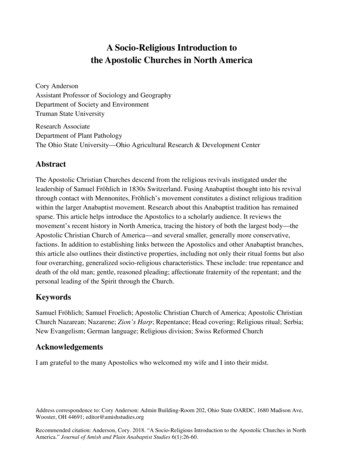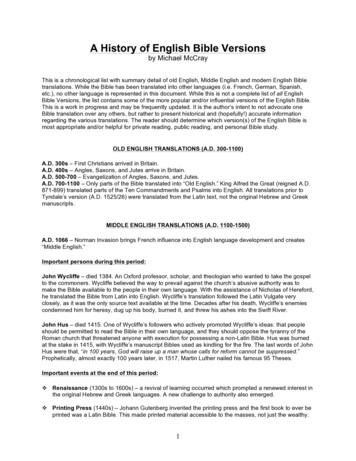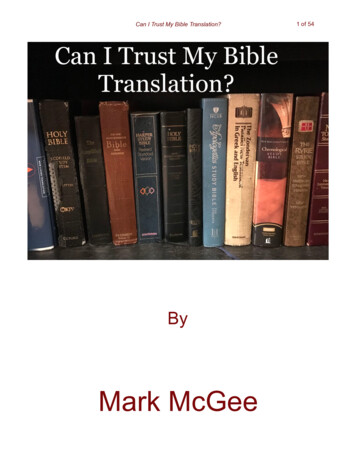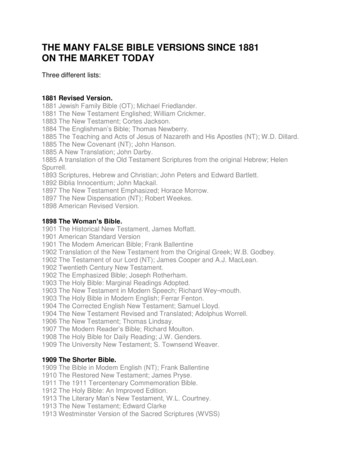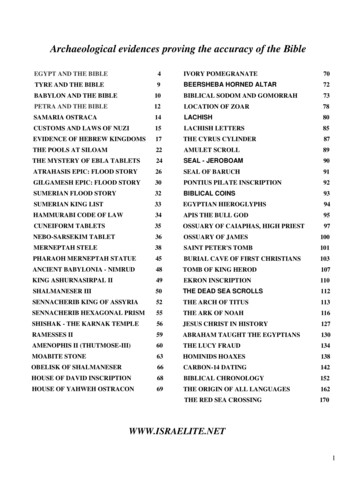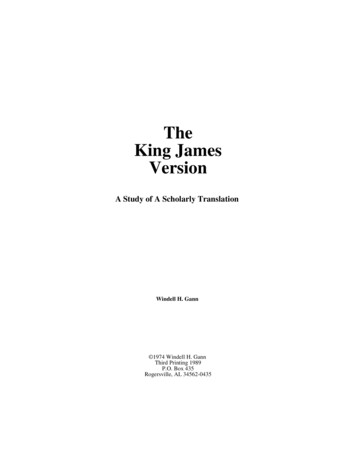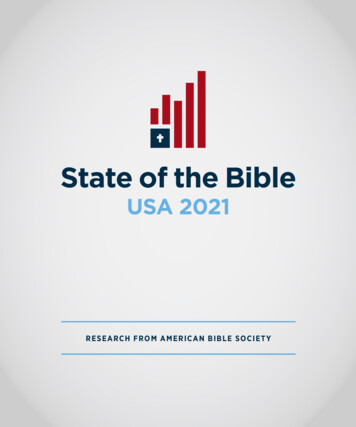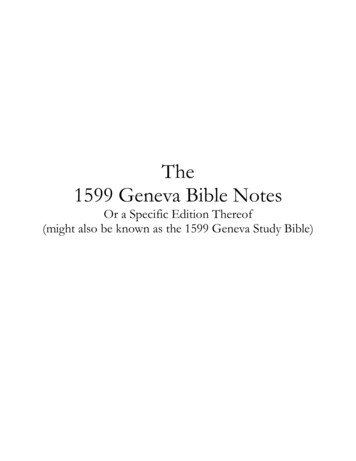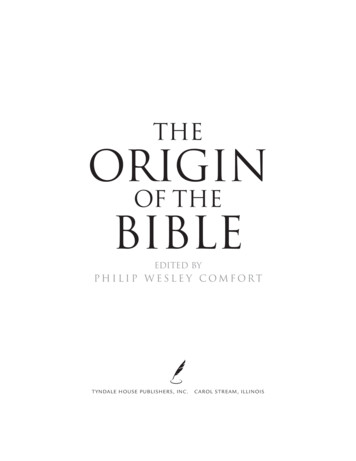
Transcription
THEAPOSTOLIC BIBLEPOLYGLOTGREEK-ENGLISH INTERLINEAR
THEAPOSTOLIC BIBLEPOLYGLOTA numerically coded Greek-English Interlinear Bible,English-Greek Index, and Lexical Concordance.THE APOSTOLIC PRESS ·NEWPORT
Amazing Grace 1996, 2013 by Charles Van der Pool. All rights reservedPublished 1996, Second Edition 2013Printed in the United States of AmericaSECOND EDITIONISBN 0-9632301-3-1The Apostolic Press547 NW Coast StreetNewport, Oregon 97365apostolicbible.com
INTRODUCTIONAPOSTOLIC BIBLE DESCRIPTIONThe Apostolic Bible Polyglot consists of three majorworks – The Apostolic Bible literal interlinear translation ofthe Greek Old and New Testaments, The Lexical Concordance of The Apostolic Bible, and The English-Greek Index of TheApostolic Bible. *See Note on the Second Edition. Thesethree works are numerically coded with the AB-Strongnumbering system.THE GREEK SCRIPTURESThe Greek Old Testament, commonly referred to asthe Septuagint or LXX, was translated from the Hebrew Scriptures approximately 250 years before theChrist. An account of this occurrence is noted in thedubious Letter of Aristeas, and can be found in theback of An Introduction to The Old Testament in Greek, by HenryBarclay Swete, 1902. Whether or not this letter is trueto the facts can be debated, but that the Greek Scriptures were well entrenched by the time of the birth ofthe Christ is undeniable.The acceptance of the Greek Scriptures can best bedescribed by a quotation in the Mishna written aroundthe time of the Christ, with Herbert Danby’s translation reading in Megillah 1.8, "The Books [of Scripture] differ from phylacteries and Mezuzahs only inthat the Books may be written in any language, whilephylacteries and Mezuzahs may be written in the Assyrian writing only. Rabban Simeon b. Gamaliel says:'The Books, too, they have only permitted to be writtenin Greek.'”At the time the New Testament was being written,the language of the common people of the Holy Landwas Aramaic, but Greek was the international languageused throughout the Mediterranean world. The signabove the head of the suffering Christ was written inHebrew, Greek and Latin, with Latin being the tongueused by the Roman military, prelates, and judiciary.The Hellenists in Jerusalem at the time of the Passionwere Greek speaking Jews, and some became Christiansas related in Acts 11:20. Also in Acts 21:37 Paul askedthe commander, “Is it allowed for me to speak to you?”The commander responded, ‘You know Greek?’”When the apostles wrote the Sacred Scriptures tovvarious churches and peoples, the common writtenform was Greek, as most of the Jews of the Diasporaunderstood Greek, and lived in areas where Greek wasspoken. It was common for the writers of the New Testament, when need arose to quote the Old Testament,to quote the Greek Scriptures rather than the HebrewScriptures.With the incorporation of the Greek Old TestamentScriptures into the Greek New Testament via quotes,surely this puts the Greek Old Testament in a uniqueposition, as these Greek Old Testament words havebecome engrafted into the Divine Word of the NewTestament. For hundreds of years after the Christ,during the formation of the apostolic age, the GreekScriptures were consistently read and quoted by theChurch Fathers. These all-Greek Scriptures are still inuse in Eastern Christendom today, although the Canonis different. The Apostolic Bible continues this tradition of The Apostolic Age Greek Scriptures, and is thusnamed The Apostolic Bible.With the fact of the Greek Old Testament partlybeing grafted into the "inspired” Greek New Testament, it is inconceivable to think one can truly understand the deep meanings of the Greek New Testamentwithout having the knowledge of the Greek Old Testament. For example, consider the following passage inthe King James Bible, "he hath made him to be sin forus " 2 Corinthians 5:21. The word for “sin” is #266“αµαρτια,” where in Numbers 6:14, and many otherplaces in the Greek Old Testament, the word,“αµαρτιαν” is translated "sin offering." “Offering” denoted by the Italics, is implied by the context, as it wastalking of animals for a sacrifice for sin. Jesus becoming the “sin offering” opens a whole new aspect of understanding this verse. That the Greek Scriptures weredesigned for the Church is a strong argument, but thisis not meant to demean the Hebrew Scriptures of theautographs. Seeing that God saw fit to communicatemainly through the written Word, it is to one’s advantage to search diligently both the Hebrew and GreekScriptures.CANONThe books of The Apostolic Bible correspond to theHebrew Canon and the current Authorized Version, as
far as book order and names. The most notable difference in book names are 1,2 Samuel, and 1,2 Kings,which in the Orthodox canon are named 1,2,3,4Kings. The Orthodox Canon, along with the RomanCanon also contains books which do not appear in theHebrew Canon, nor the current Authorized Version ofthe English Bible, such as the books of Baruch andMaccabees, commonly called the “Apocrypha.” TheApostolic Bible follows the book order of the currentAuthorized Version of the English Bible. It must benoted that many other book arrangements have appeared in various Bible manuscripts and printed editions over the centuries. For example, Tyndale’s NewTestament follows a different book order than theAuthorized Version, and has the Book of Hebrews following 3 John. The development of the Holy Scriptures of the early church readily adhered to the allGreek Scriptures of both Old and New Testaments,rather than a Hebrew Old Testament-Greek New Testament structure which is prevalent today in the English Bible. This all-Greek mode was the norm in Western Churches for hundreds of years during the development of the Latin, Syriac and Coptic Scriptures.The Greek Fathers, Clement, Eusebius, and many others, all writing in Greek, quoted the Greek Old andNew Testaments extensively.agreed. But since that time the acquisition of a full setof the Complutensian Polyglot Bible in facsimile format enabled a closer comparison to be made, not onlyof variant readings, but also chapter and verse variations, along with punctuation. As various manuscriptsbecome available, these will also be compared with thetext of The Apostolic Bible, and changes may be made.The Vatopedi manuscript, available from the Library ofCongress in microfilm form, is one such manuscriptamong many that will be used for comparison.APOSTOLIC BIBLE STRUCTUREThe history of interlinear Bibles goes back into themanuscript age where interlinear Bibles appear withvarious language combinations. For example, theninth century Codex Boernerianus displays the Greektext of the Pauline Epistles with the Latin appearingabove every Greek word. The earliest printed GreekBible, the Complutensian Polyglot, has an interlinearGreek-Latin text for the Old Testament, with the Hebrew Scriptures being in a separate column. Given theintroduction of the numbering system of James Strong,interlinear Bibles took on a three line format with theStrong’s number appearing above the Greek and Hebrew texts, and the English below.The Apostolic Bible is the first numerically codedGreek Old Testament, and it allows the student of theWord to study both Testaments in the same language,and to follow the association of a word from either theNew Testament to the Old Testament, or vice versa.The Apostolic Bible trilinear format has the AB-Strongnumbers on the top line, the Greek text on the middleline, and the English translation on the bottom line.The Apostolic Bible text is separated into books, chapters, section headings, verses, and footnotes.APOSTOLIC BIBLE GREEK TEXTThe Apostolic Bible was not begun with the thoughtof a new Bible translation, but was the result of years ofprivate studies that evolved into The Apostolic Bible.The original typed text followed the Vaticanus-Sixtinetext family. Then with the acquisition of the 1519Aldine Bible in microfilm format from the Koninklijke Bibliotheek, of the Netherlands, a comparisonwas made between the Sixtine and Aldine texts, whereone reading was chosen over the other. With the acquisition of the 1709 edition of the Greek Old Testament,edited by Lambert Bos, the 1518 Complutensian Polyglot variants, located in the extensive footnote sections,were added for comparison with the Sixtine and Aldinetexts. With further comparison it was decided tochoose mainly the text where two printed editionsAB-Strong Numbering SystemIn 1890, James Strong developed his monumentalwork, The Exhaustive Concordance of the Bible, containingevery English word of the Authorized Version, commonly called the King James Version. Included in thismonumental work are two companion dictionaries ofthe Hebrew and Greek Scriptures. The first dictionaryvi
is, A Concise Dictionary of the Words in the Hebrew Bible, numerically coded, containing 8674 Hebrew words withEnglish definitions corresponding to the ExhaustiveConcordance. The second dictionary is, A Concise Dictionary of the Words in the Greek Testament, numerically coded,containing 5624 Greek words with English definitionscorresponding to the Exhaustive Concordance. As theEnglish Authorized Version is based on the HebrewOld Testament and Greek New Testament, a problemarose when it was decided to numerically code theGreek Old Testament, which had not been coded byJames Strong. It was decided to adapt the Strong’s NewTestament Greek Dictionary numbering system to TheApostolic Bible, and to furnish numbers for the GreekOld Testament words that were not included inStrong’s Greek Dictionary of the New Testament, byalphabetically inserting new numbers delineated bydecimal points between the existing Strong’s New Testament Greek words. Hence, a word with an ABStrong number with a decimal point generally meansthat that word appears only in the Greek Old Testament. In some cases various Strong’s numbers havebeen merged into one number, mainly concerning theverb “ειµι,” or “to be” where James Strong had subdivided the word “ειµι“ by tense and mood and had giveneach conjugation its own number. But now these wordshave been combined into one basic number - #1510.Likewise the personal pronoun “εγω,” or “I” was subdivided by case and number, and each declension wasgiven its own AB-Strong number. These words are nowcombined into number - #1473. Whenever a mergerof Strong's numbers does occur, it will be noted in theLexical Concordance under the old number.printed Greek texts (mainly developed with the Sixtineedition).footnotesThe footnotes in The Apostolic Bible are for reference purposes only, and not commentaries. Daggers inthe text denote footnote usage, and have complementary dagger marks in the footnotes for the markedverse. The abbreviations used in the footnotes are explained in the abbreviations list below. The mostcommon footnote, “see Bos for variants," refers to theVetus Testamentum LXX, published in Holland in1709, and edited by Lambert Bos. The main text ofthe Bos Bible is a reprint of the 1587 edition of theVatican manuscript Codex B, or Sixtine Edition. Thereference “Six.” refers exclusively to the text of the BosBible rather than its footnotes. The reference "CP"refers to the Complutensian Polyglot Bible printed inAlcala, Spain in 1517, but with most of its variantslisted in the Bos footnotes. The reference "Ald.” refersto the Aldine Bible printed in Venice, Italy in 1518, byAldus Manutius, containing the Old and New Testaments in Greek only, but with most of its variants alsolisted in the Bos footnotes. *See Note on the SecondEdition.abbreviationsAdvb. - AdverbAld. - Aldine EditionAlex. - Codex AlexandrinusAram. - AramaicChald. - ChaldeanCP - Complutensian Polyglot Bibledim. - diminutiveet seq. – and the followingHeb. - Hebrewi.e. - that islit. – literal; literallySix. - Sixtinesubstv. - substantivetranslt. - transliterationviz – namelysection headings, chapters and versesSection headings appear in The Apostolic Bible toenable one to quickly find a particular section of theBible. Chapter and verse numbering in The ApostolicBible generally follows the current Authorized Versionmodel. The Complutensian Polyglot Bible agrees withthe Hebrew as far as book and chapter order muchmore closely than the Sixtine or Aldine Greek editions.The Apostolic Bible follows the Complutensian Polyglot model which varies somewhat from the traditionalvii
accent marks and pronunciationThe earliest Greek Bible manuscripts were writtenin the uncial form; that is, capital letters, and they hadfew or no accent marks. Without going into great detail on the development of accent marks, let it be notedthat volume 5 of the Complutensian Polyglot Bible,printed in 1518, contains a New Testament text that isaccented with only one accent mark; that is, the acute,over the vowel being emphasized. The 1843 2-volumeset of William Pickering's Greek New Testamentcontains largely an unaccented edition of the GreekNew Testament. The Apostolic Bible has a single dotabove the vowel, or vowels which take the emphasis.With some unaccented Greek words, called enclitics,the preceding Greek word can take accents over morethan one vowel.directly under their Greek words. Another example isin Genesis 1:11 with the hyphen structure,2036-3588-2316eipen o qeoVGod saidwhich would literally be, “said the God,” but is translated, “God said.” Hyphen structures are also foundwith most far & wide words listed on page vii. InGenesis 2:10 the hyphen structure,4215-1161potamoV deAnd a riverwould literally read, “river and,” but is translated,“And a river.” A final example of a type of hyphenstructure appears in Acts 1:13,bracket structuresCommon English word order has the subject listedbefore the verb; for example, "the sufferings of theChrist abound." Greek word order may differ by having the verb appear before the subject; for example,"abound the sufferings of the Christ." For clarity thebracket structure is used with a follow-the-numberscheme.40523588 380435885547perri
Testament Greek Dictionary numbering system to The Apostolic Bible, and to furnish numbers for the Greek Old Testament words that were not included in Strong’s Greek Dictionary of the New Testament, by alphabetically inserting new numbers delineated by decimal points between the existing Strong’s New Tes-tament Greek words. Hence, a word with an AB-Strong number with a decimal point .

